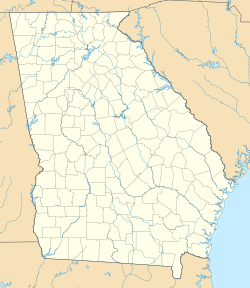Woodall–Patton House and Post Office facts for kids
Quick facts for kids |
|
|
Woodall–Patton House and Post Office
|
|
| Nearest city | Ellaville, Georgia |
|---|---|
| Area | 1 acre (0.40 ha) |
| Built | 1871 |
| NRHP reference No. | 01001432 |
| Added to NRHP | January 11, 2002 |
The Woodall–Patton House and Post Office is a special old building near Ellaville, Georgia. People also know it as the Schley Post Office or Patton Hill Post Office. It's located on GA 240, about three miles west of US19. This route connects the towns of Buena Vista and Oglethorpe. A long time ago, this building was a working post office from 1888 to 1905.
Contents
What is the Woodall–Patton House?
The Woodall–Patton House is a one-story building made of wood. It's built in a style called "double pen," which means it has two main rooms side-by-side. The roof is shaped like a pyramid, which is called a "hipped roof."
The house has chimneys made of brick. It stands on brick supports, called "piers." There's also a porch that runs along the entire front of the house.
A House and a Post Office
From 1888 to 1905, one of the front rooms of this house was used as the official U.S. Post Office. It served the northwest part of Schley County and was known as the "Schley, Georgia" post office.
The people who lived in the house were also the postmasters. James W. Woodall was the postmaster from 1888 to 1893. After him, his sister, Mary Ella Woodall Patton, took over from 1893 to 1905.
Why is it a Historic Place?
The Woodall–Patton House was added to the National Register of Historic Places in 2002. This means it's an important building that tells us about history.
Experts said it's a great example of a "double pen" house. It's special because it hasn't been changed much over the years. It still has its original shape, room layout, floors, walls, ceilings, and doors. Even the original porcelain doorknobs are still there!
The house helps us understand what rural farm homes looked like after the American Civil War.
Other Buildings on the Property
There was also a small wooden building called a "smokehouse" on the property. Smokehouses were used to cure and preserve meat. This smokehouse was also considered an important part of the historic property.


